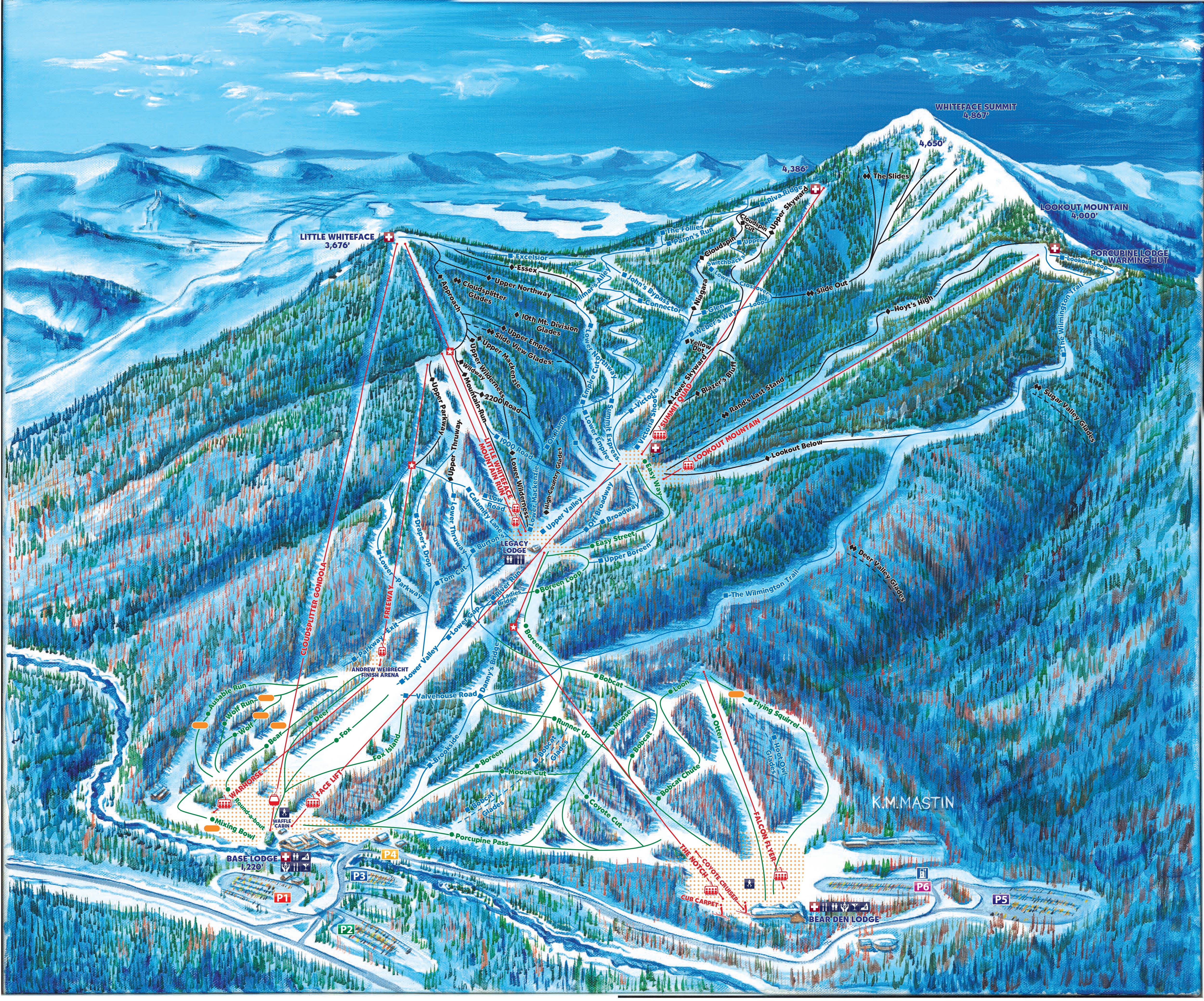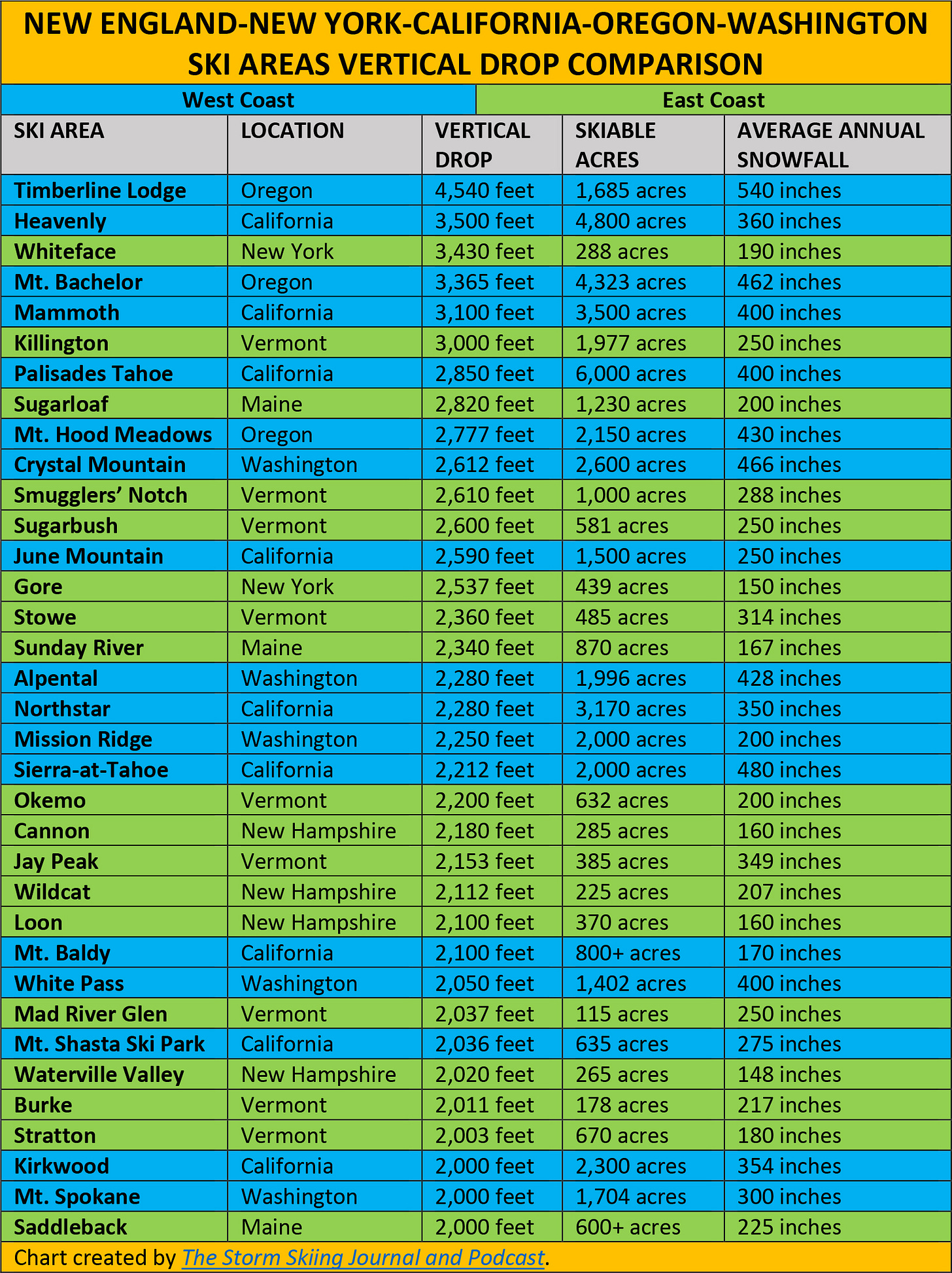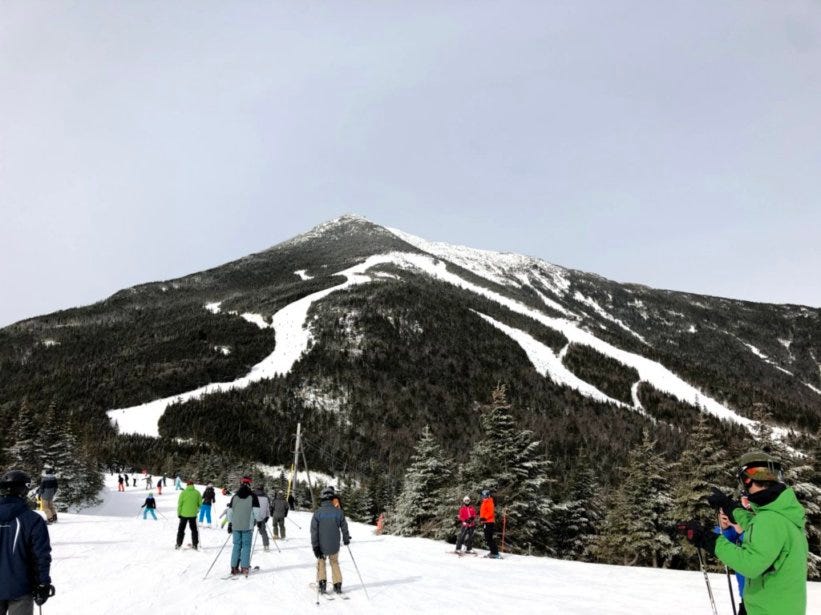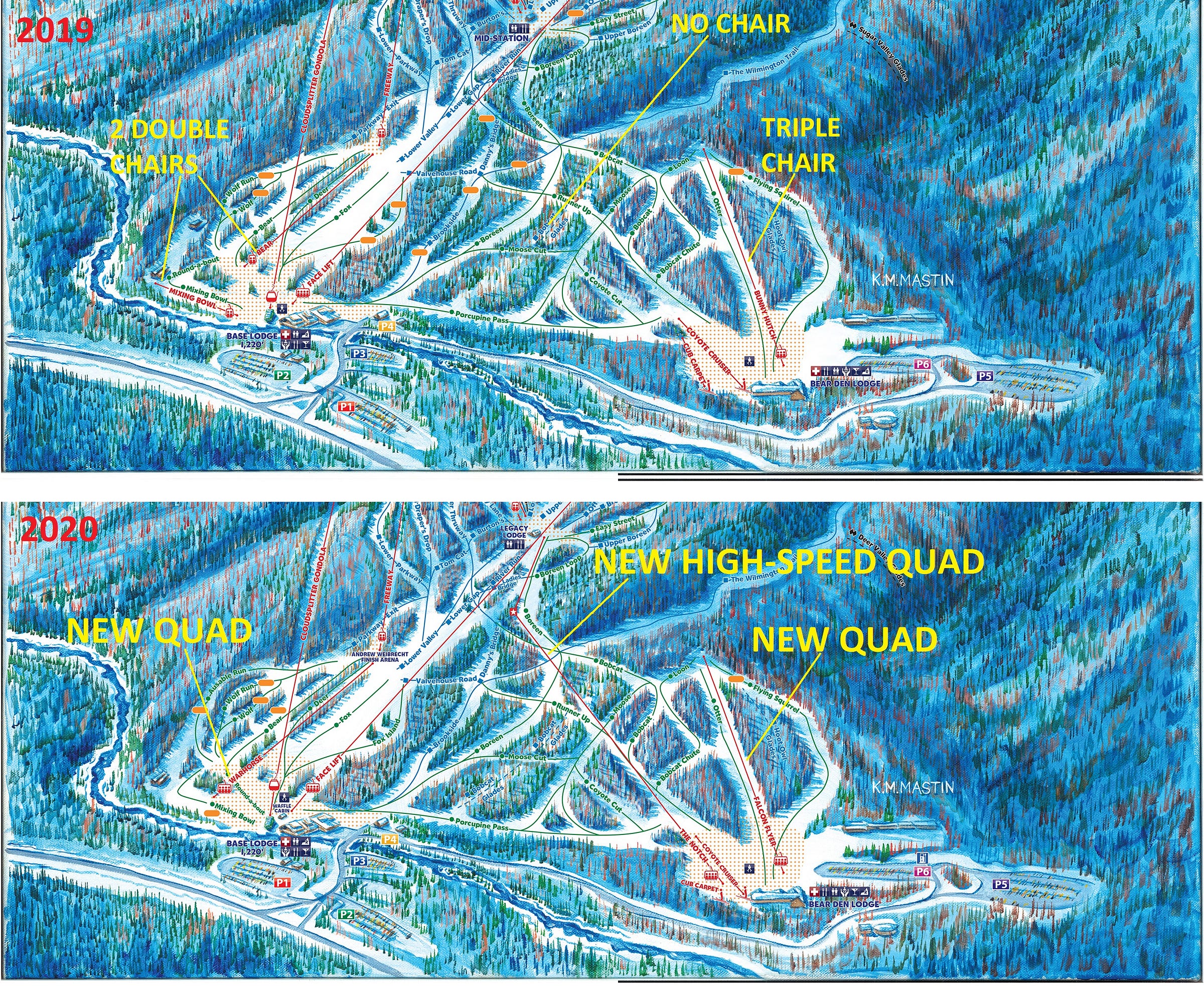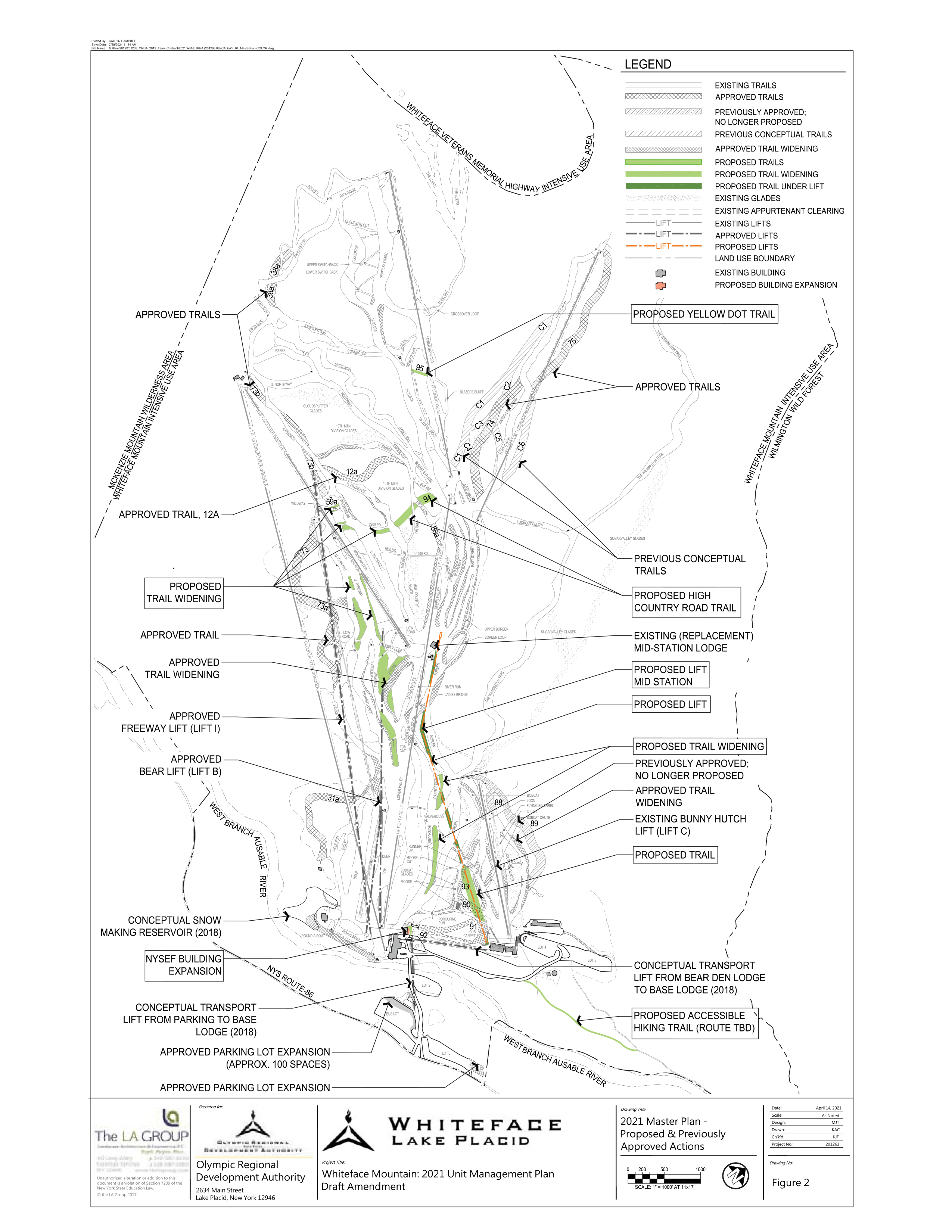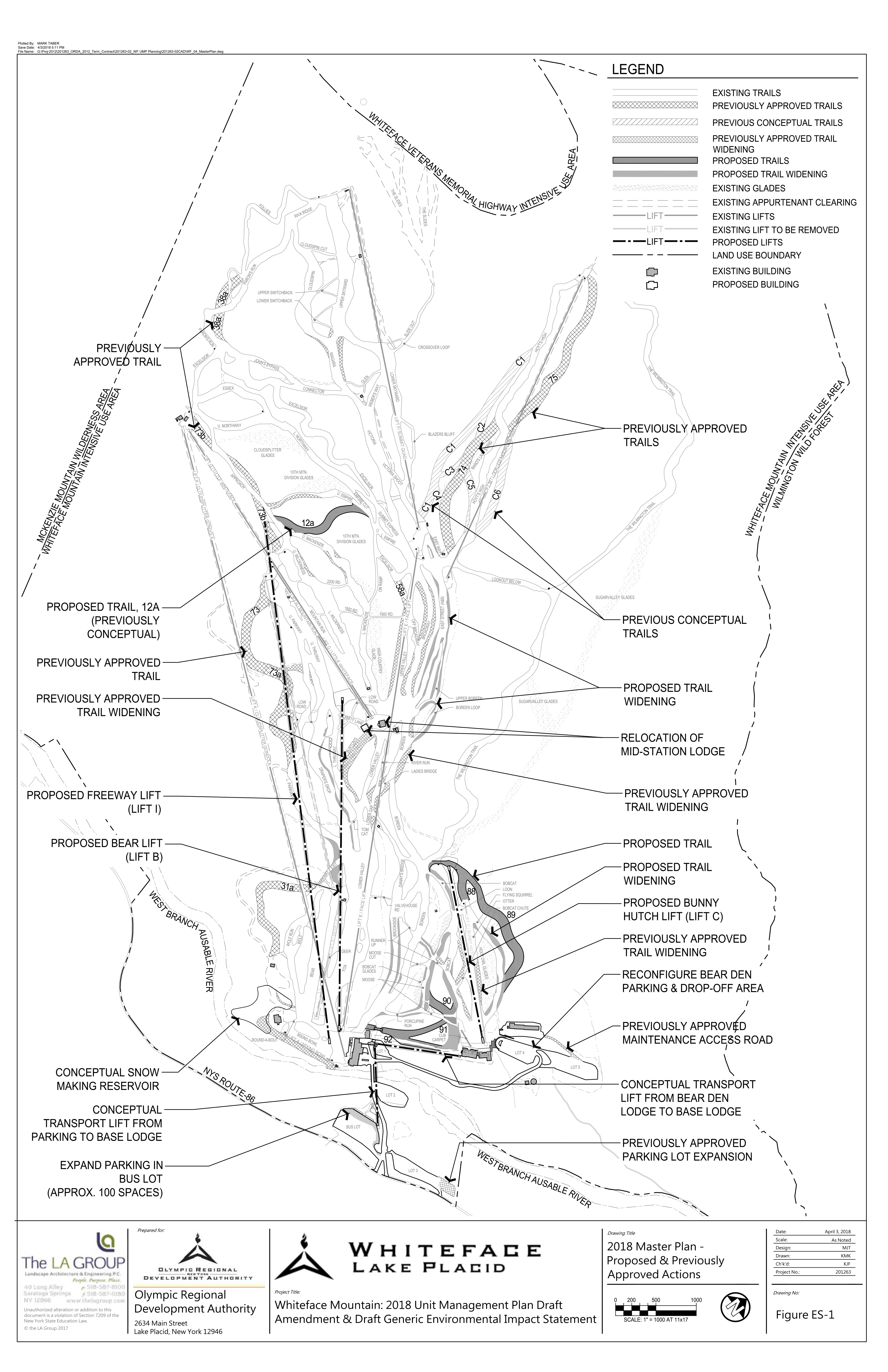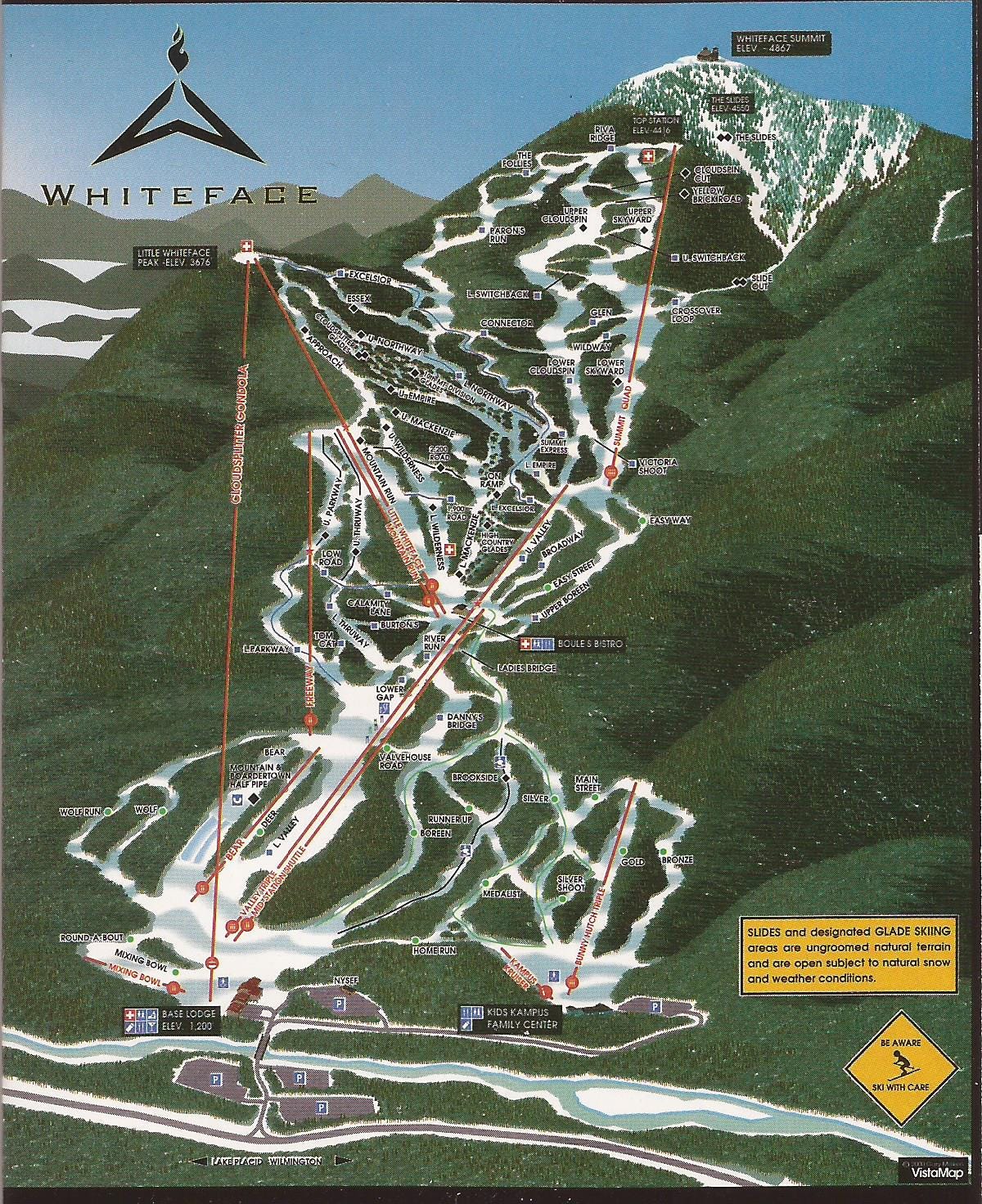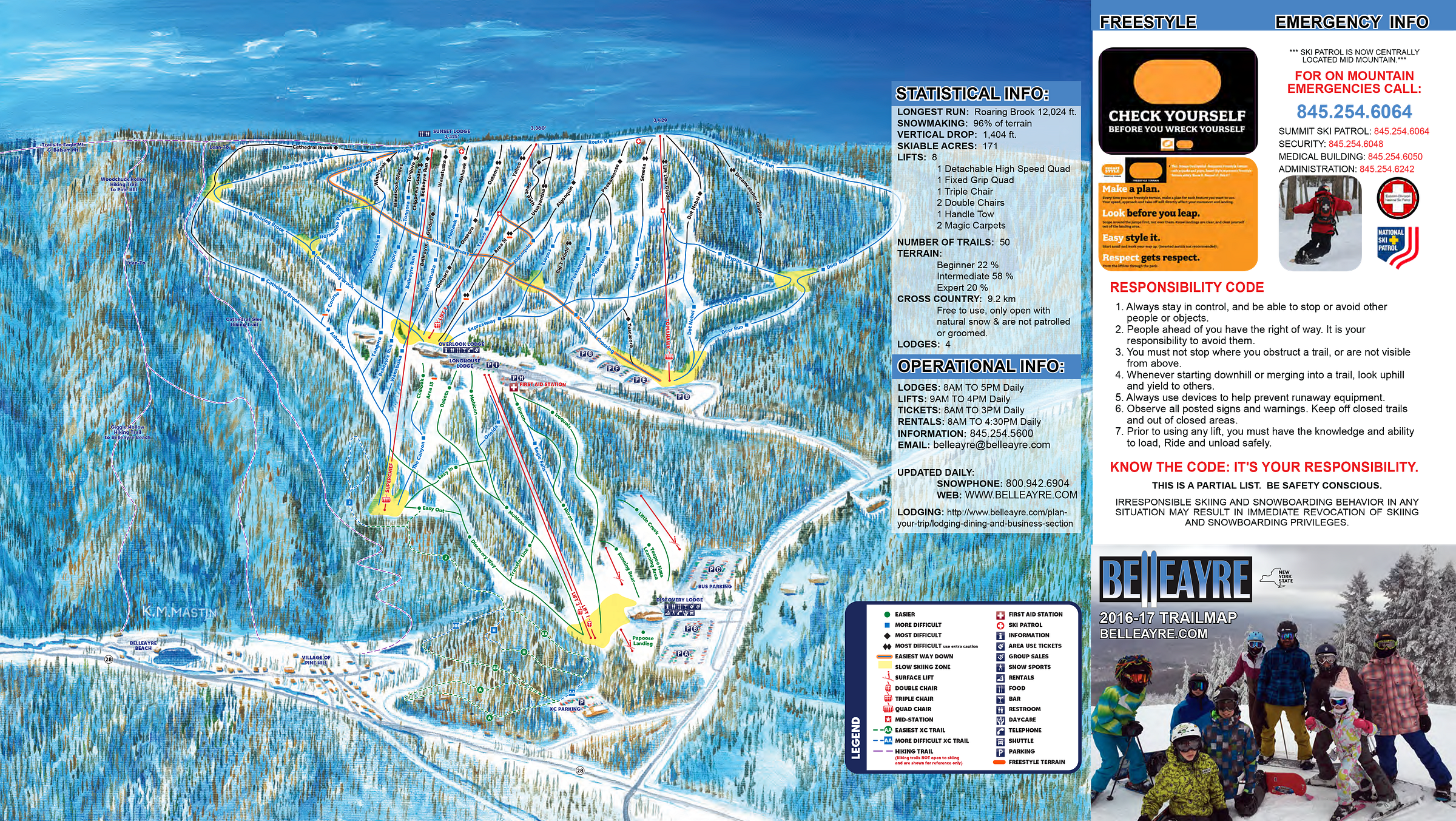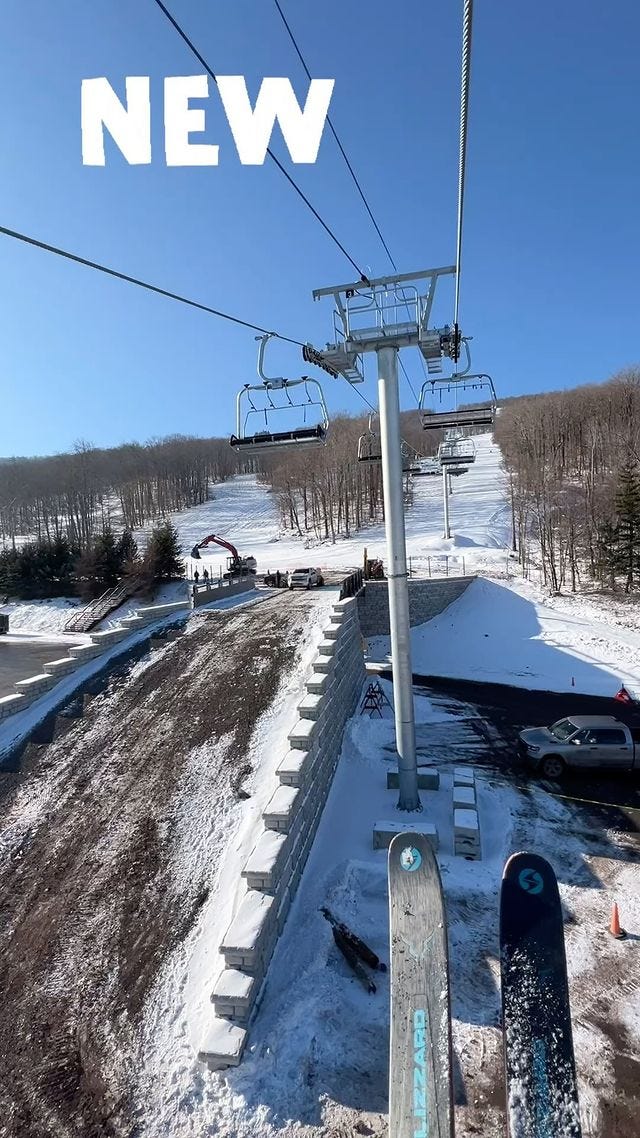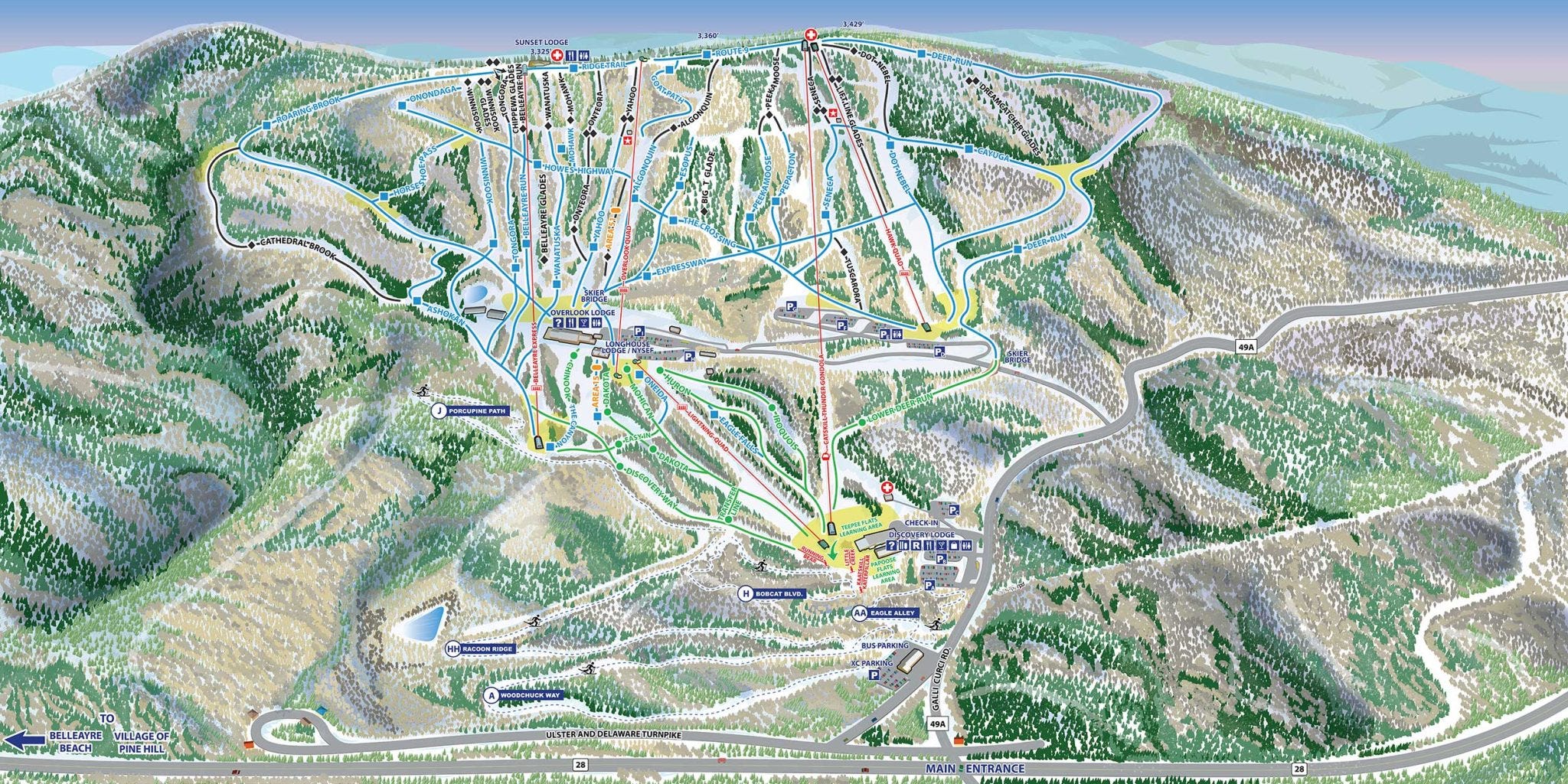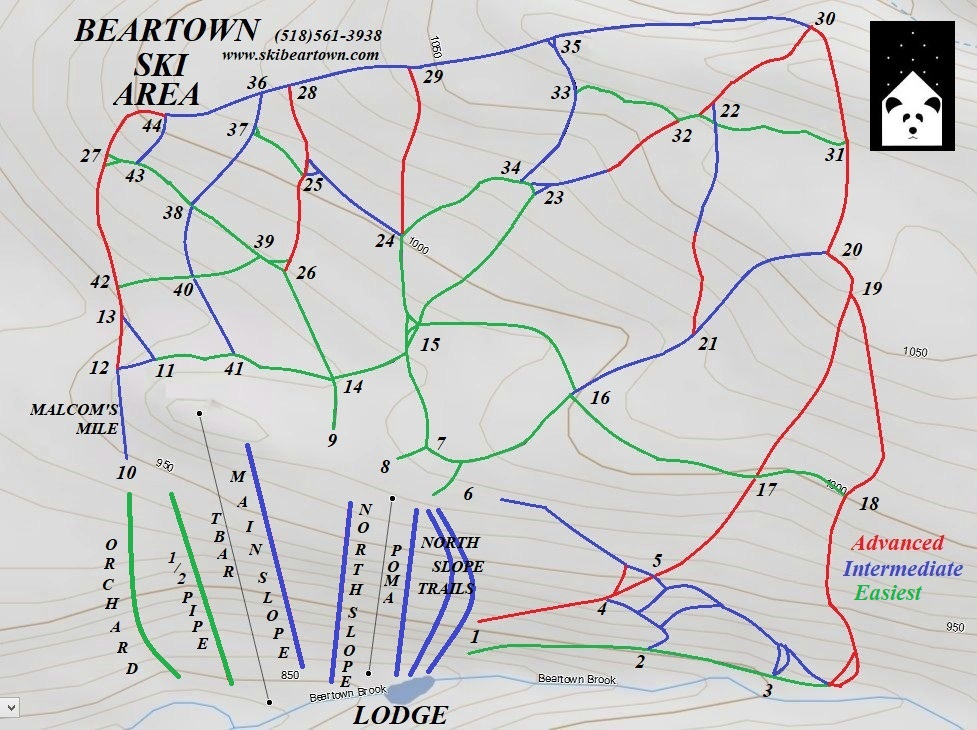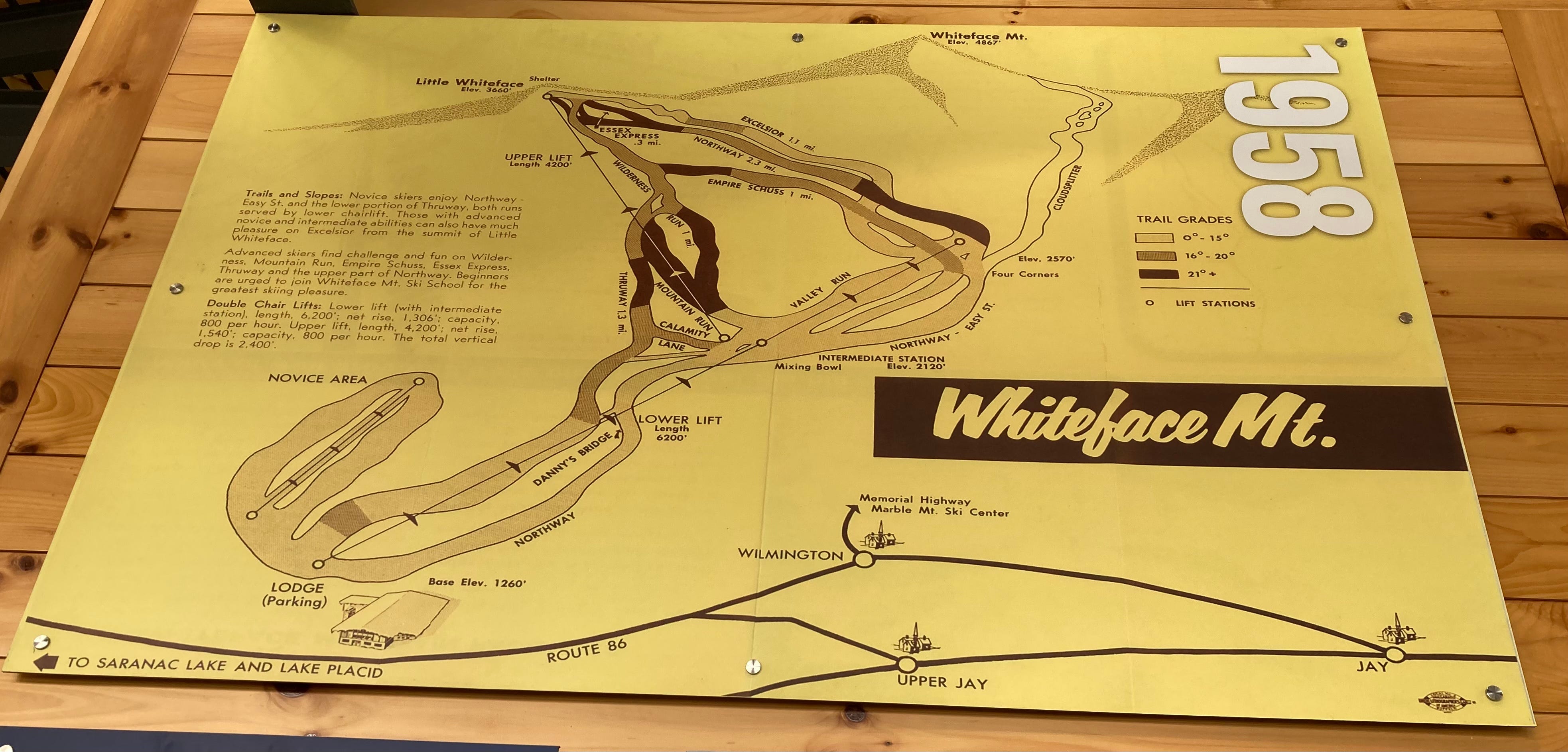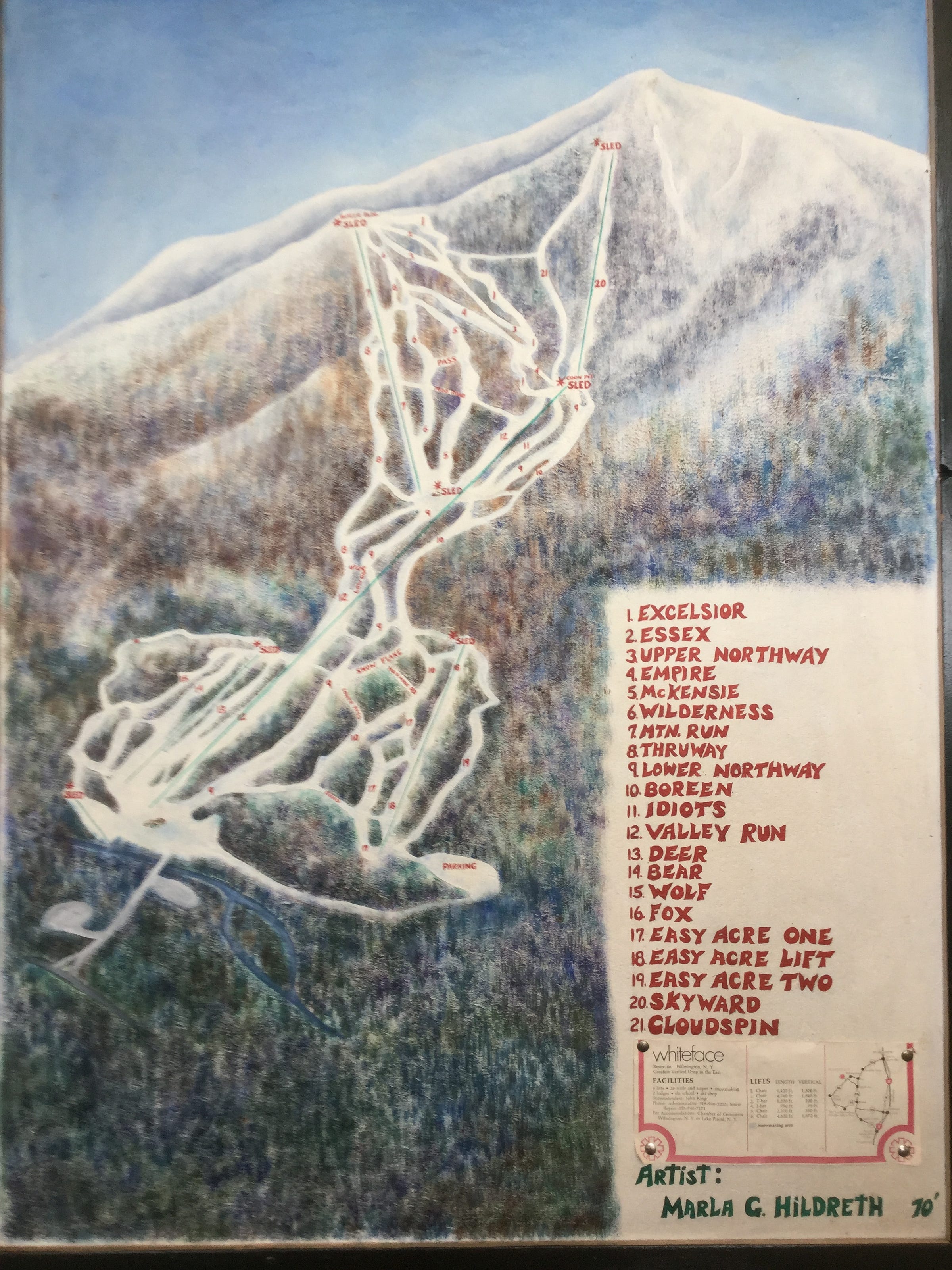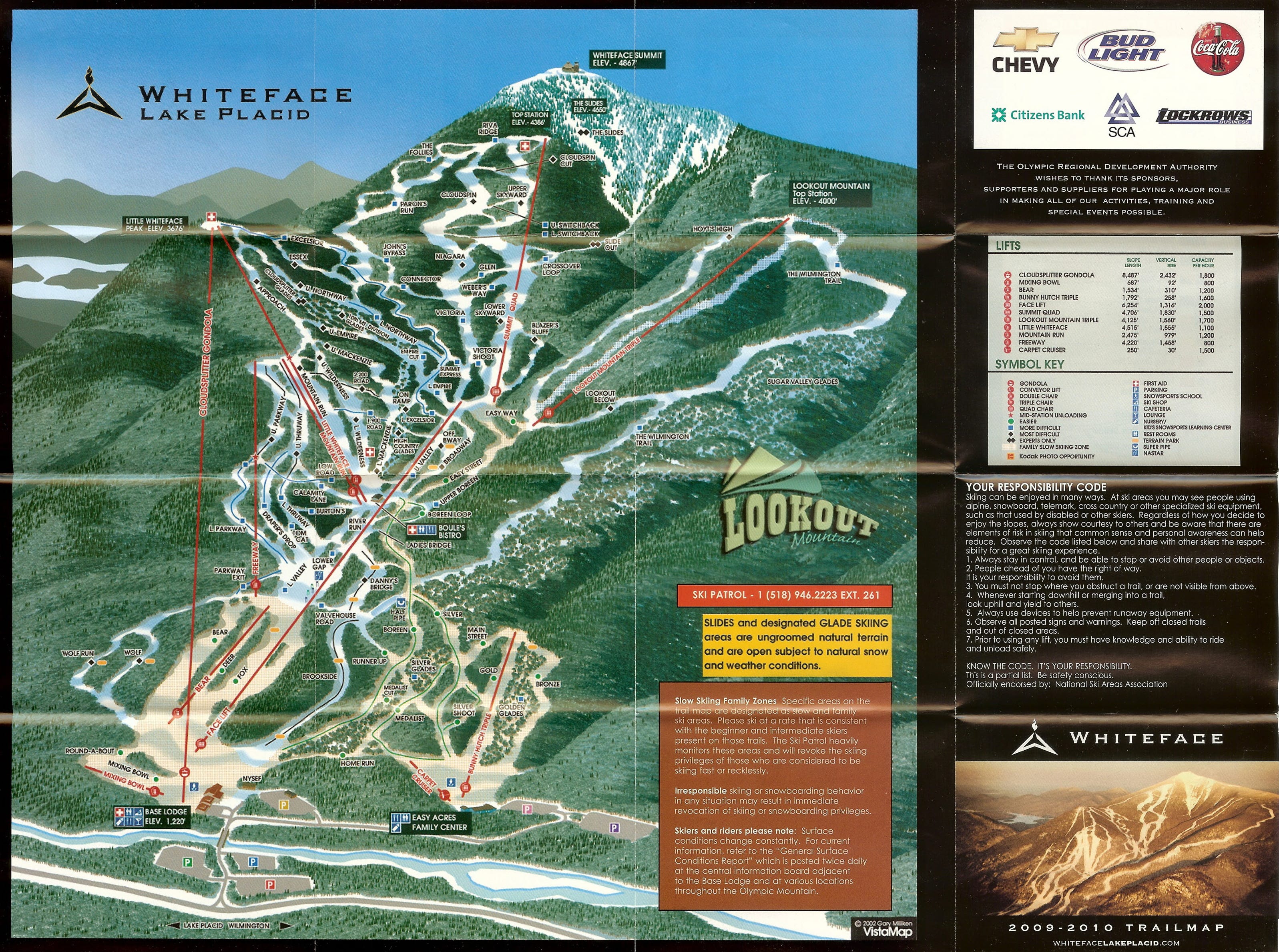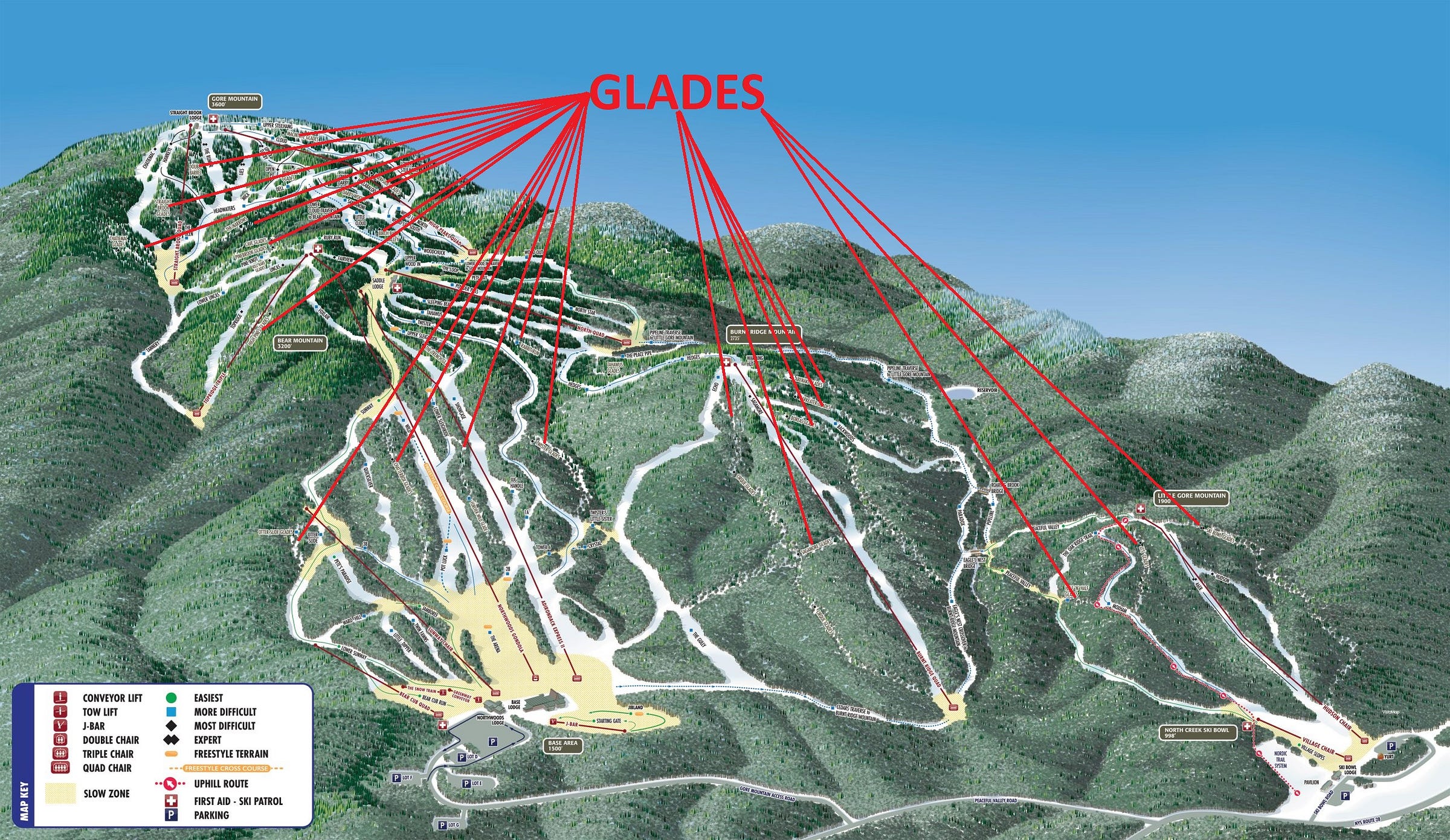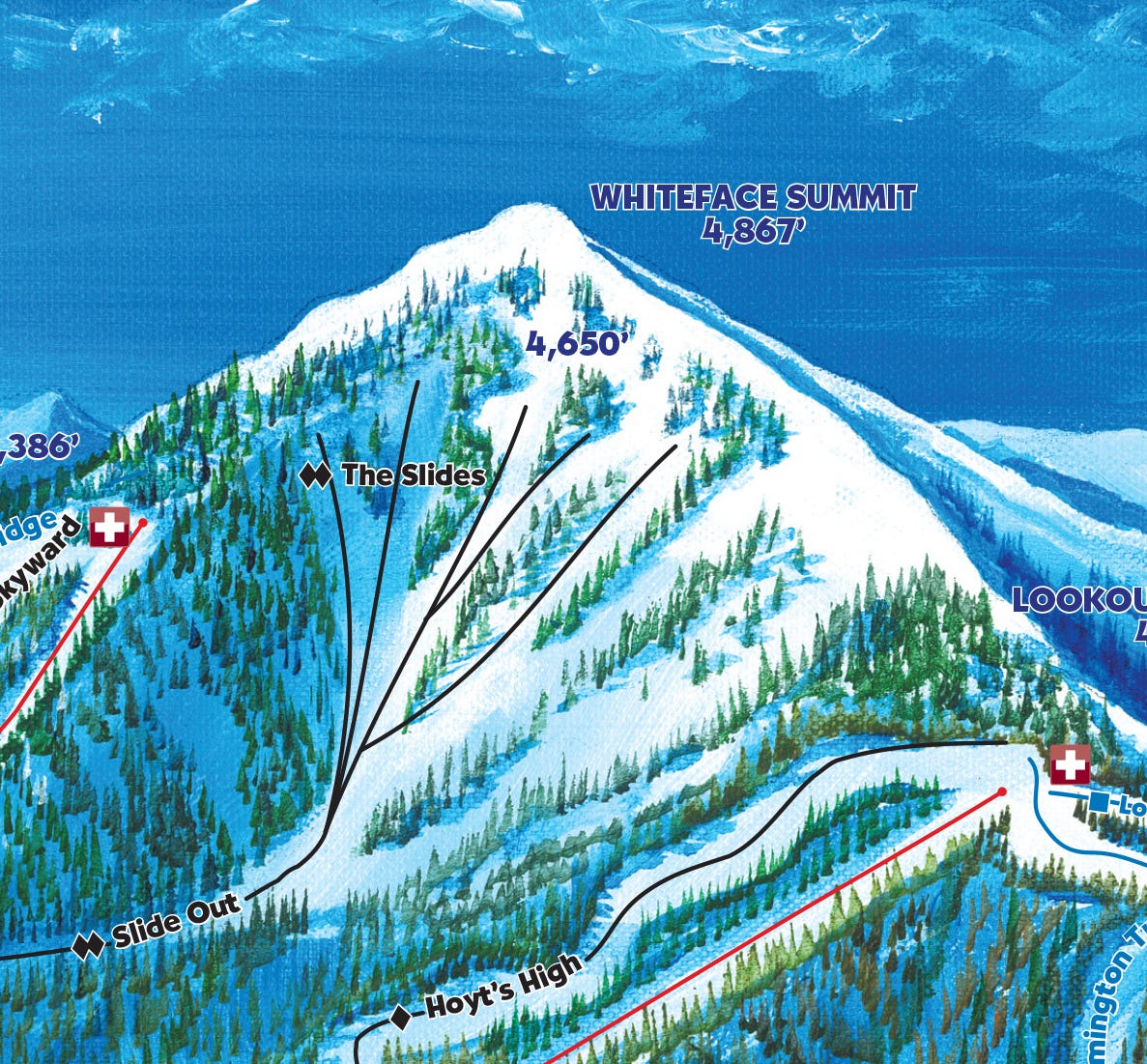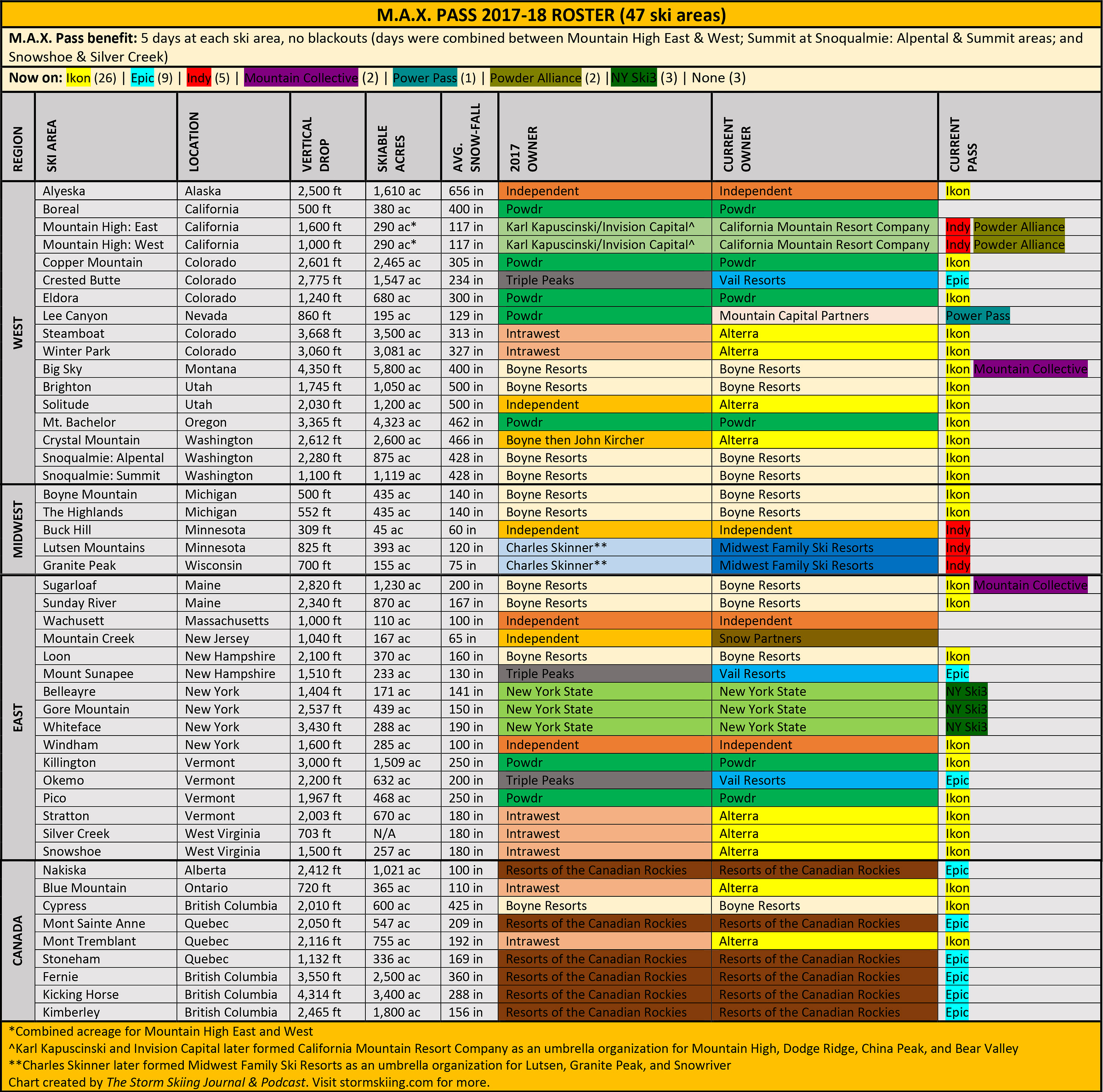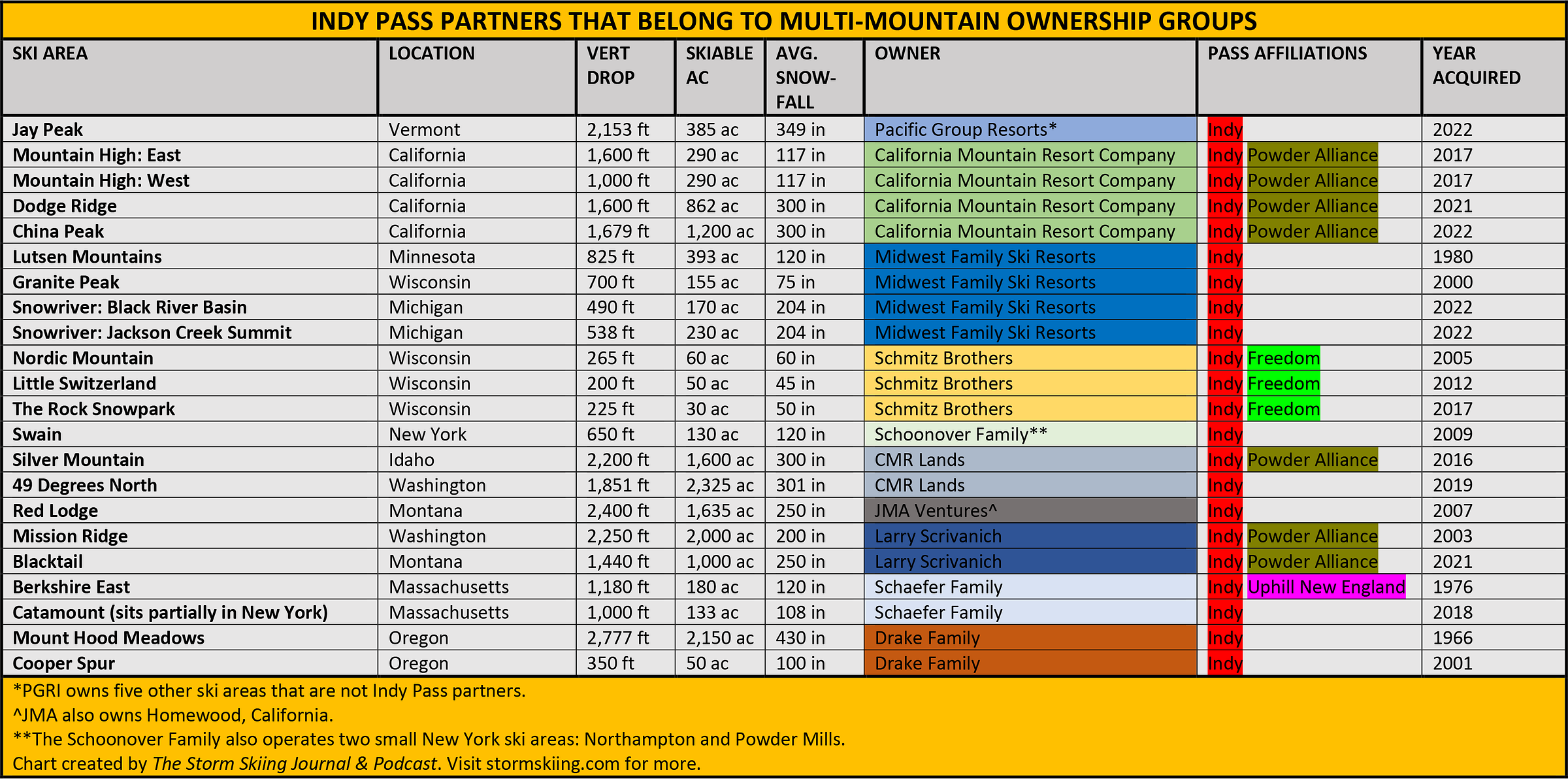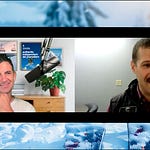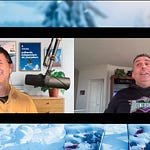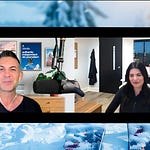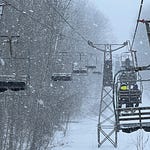Who
Aaron Kellett, General Manager of Whiteface, New York
Recorded on
December 4, 2023
About Whiteface
View the mountain stats overview
Owned by: The State of New York
Located in: Wilmington, New York
Year founded: 1958
Pass affiliations: NY Ski3 Pass: Unlimited, along with Gore and Belleayre
Closest neighboring ski areas: Mt. Pisgah (:34), Beartown (:55), Dynamite Hill (1:05), Rydin-Hy Ranch (1:12), Titus (1:15), Gore (1:21)
Base elevation: 1,220 feet
Summit elevation:
4,386 feet (top of Summit Quad)
4,650 feet (top of The Slides)
4,867 feet (mountain summit)
Vertical drop: 3,166 feet lift-served; 3,430 feet hike-to
Skiable Acres: 299 + 35 acres in The Slides
Average annual snowfall: 183 inches
Trail count: 94 (30% expert, 46% intermediate, 24% beginner)
Lift count: 12 (1 eight-passenger gondola, 2 high-speed quads, 3 fixed-grip quads, 1 triple, 3 doubles, 2 carpets – view Lift Blog’s inventory of Whiteface’s lift fleet)
View historic Whiteface trailmaps on skimap.org.
Why I interviewed him
Whiteface, colloquially “Iceface,” rises, from base to summit, a greater height than any ski area in the Northeast. That may not impress the Western chauvinists, who refuse to acknowledge any merit to east-of-the-Mississippi skiing, but were we to airlift this monster to the West Coast, it would tower over all but two ski areas in the three-state region:
The International Olympic Committee does not select Winter Games host mountains by tossing darts at a world map. Consider the other U.S. ski areas that have played host: Palisades Tahoe, Park City, Snowbasin, Deer Valley. All naturally blessed with more and more consistent snow than this gnarly Adirondacks skyscraper, but Whiteface, from a pure fall-line skiing point of view, is the equal of any mountain in the country.
Still not convinced? Fine. Whiteface will do just fine without you. This state-owned, heavily subsidized-by-public-funds monster seated in the heart of the frozen Adirondacks has just about the most assured future of any ski area anywhere. With an ever-improving monster of a snowmaking system and no great imperative to raise the cannons against Epkon invaders, the place is as close to climate-proof and competition-proof as a modern ski area can possibly be.
There’s nothing else quite like Whiteface. Most publicly owned ski areas are ropetow bumps that sell lift tickets out of a woodshed on the edge of town. They lean on public funds because they couldn’t exist without them. The big ski areas can make their own way. But New York State, enamored of its Olympic legacy and eager to keep that flame burning, can’t quite let this one go. The result is this glimmering, grinning monster of a mountain, a boon for the skier, bane for the tax-paying family-owned ski areas in its orbit who are left to fight this colossus on their own. It’s not exactly fair and it’s not exactly right, but it exists, in all its glory and confusion, and it was way past time to highlight Whiteface on this podcast.
What we talked about
Whiteface’s strong early December (we recorded this before the washout); recent snowmaking enhancements; why Empire still doesn’t have snowmaking; May closings at Whiteface; why Whiteface built The Notch, an all-new high-speed quad, to serve existing terrain; other lines the ski area considered for the lift; Whiteface’s extensive transformation of the beginner experience over the past few years; remembering “snowboard parks” and the evolution of Whiteface’s terrain parks; Whiteface’s immense legacy and importance to Northeast skiing; could New York host another Winter Olympics?; potential upper-mountain lift upgrades; the etymology of recent Whiteface lift installations; Lookout Mountain; potential future trails; how New York State’s constitution impacts development at Whiteface; why Whiteface doesn’t offer more glades; The Slides; why Whiteface doesn’t have ski-in, ski-out lodging; and whether Alterra invited Whiteface and its sister mountains onto the Ikon Pass in 2018, and whether they would join today.
Why I thought that now was a good time for this interview
Over the past three years, Whiteface has quietly remade its beginner experience with a series of lower-mountain lift upgrades: the old triple chair on the Bear Den side (which Kellett notes was Whiteface’s original summit chair) made way for a new Skytrac fixed-grip quad in 2020. The next year, the Mixing Bowl and Bear doubles out of the main base came out for another new Skytrac quad. Then, earlier this month, Whiteface opened The Notch, a brand-new, $11.2 million Doppelmayr high-speed quad with an angle station to seamlessly transport skiers from Bear Den up to mid-mountain, from which point they can easily lap the kingdom of interlaced greens tangled below. Check out the before and after:
It’s a brilliant evolution for a mountain that has long embraced its identity as a proving ground for champions, a steep and icy former Olympic host comfortable scaring the hell out of you. Skiing has a place for radsters and Park Brahs and groomer gods arcing GS turns off the summit. But the core of skiing is families. They spend the most on the bump and off, and they have options. In Whiteface’s case, that’s Vermont, the epicenter of Northeast skiing and home to no fewer than a dozen fully built-out and buffed-up ski resorts, many of which belong to a national multimountain pass that committed ski families are likely to own. To compete, Whiteface had to ramp up its green-circle appeal.
I don’t think the world has processed that fact yet, just as I don’t think they’ve quite understood the utter transformations at Whiteface sister resorts Belleayre and Gore. The state has plowed more than half a billion dollars into ORDA’s facilities since 2017. While some of that cash went to improve the authority’s non-ski facilities in and around Lake Placid (ice rinks and the like), a huge percent went directly into new lifts, snowmaking, lodges, and other infrastructure upgrades at the ski mountains.
For context, Alterra, owner of 18 ski areas in the U.S. and Canada, reported in March that they had invested $1 billion into their mountains since the company’s formation in 2017. To underscore the magnitude of ORDA’s investment: any one of Alterra’s flagship western properties – Mammoth (3,500 acres), Palisades Tahoe (6,000), Winter Park (3,081), Steamboat (3,500), Crystal (2,600) – is many times larger than Whiteface (288), Gore (439), and Belleayre (171) combined (898 total acres, or just a bit smaller than Aspen Mountain). No ski areas in America have seen more investment in proportion to their size in recent years than these three state-owned mountains.
I also wanted to touch on a topic that gnaws at me: why Alterra, when it cleaned out the M.A.X. Pass, overlooked so many strong regional mountains that could have turbocharged local sales. I got into this with Lutsen Mountains GM Jim Vick in October, and Kellett humors me on this question: would Whiteface have joined the Ikon Pass had it been invited in 2018? And would they join now, given the success and growth of the Ski 3 Pass over the past six years? The answers are not what you might think.
Questions I wish I’d asked
I probably should have asked about the World University Games, which Whiteface and Lake Placid spent years and millions of dollars to prepare for. I don’t cover competition, but I do admire spectacles, and more than an allusion to the event would have been appropriate for the format. We do, however, go deep on the possibility of the Olympics returning to New York.
Also, I don’t get into the whole ORDA-public-funding-handicapping-New-York’s-small-ski-areas thing, even though it is a thing, and one that independent operators rightly see as an existential threat. I do cover this dynamic often in the newsletter, but I don’t address it with Kellett. Why? I’ll reset here what I said when I hosted Gore GM Bone Bayse on the podcast last year:
Many of you may be left wondering why my extensive past complaints about ORDA largess did not penetrate my line of questioning for this interview. Gore is about to spend nearly $9 million to replace a 12-year-old triple chair with a high-speed quad. There is no other ski area on the continent that is able to do anything remotely similar. How could I spend an hour talking to the person directing this whole operation without broaching this very obvious subject?
Because this is not really a Gore problem. It’s not even an ORDA problem. This is a New York State problem. The state legislature is the one directing hundreds of millions of taxpayer dollars to three ski areas while the majority of New York’s family-owned mountains pray for snow. I am not opposed to government support of winter sports. I am opposed to using tax dollars from independent ski areas that have to operate at a profit in order to subsidize the operations of government-owned ski areas that do not. There are ways to distribute the wealth more evenly, as I’ve outlined before.
But this is not Bayse’s fight. He’s the general manager of a public ski area. What is he supposed to do? Send the $9 million back to the legislature and tell them to give it to Holiday Mountain? His job is to help prioritize projects and then make sure they get done. And he’s really good at that job. So that – and not bureaucratic decisions that he has no control over – was where I took this conversation.
No need to rewrite it for Whiteface because the sentiment is exactly the same.
What I got wrong
I called the Empire trail “Vampire” because that’s what I’d thought Kellett had called it and I’m not generally great about memorizing trail names. But no such trail exists. Sorry Whiteface Nation.
I said the mid-mountain lodge burned down in “2018 or 2019.” The exact date was Nov. 30, 2019.
I said that there had been “on the order of a billion dollars in improvements to ORDA facilities over the past decade… or at least several hundred million.” The actual number, according to a recent report in Adirondack Life, is $552 million over just six years.
Why you should ski Whiteface
Two hundred and ninety-nine acres doesn’t sound like much, like something that fell off the truck while Vail was putting the Back Bowls in storage for the summer, like a mountain you could exhaust in a morning on a set of burners over fresh cord.
But this is a state-owned mountain, and they measure everything in that meticulous bureaucratic way of The Official. Each mile of trail is measured and catalogued and considered. Because it has to be: New York State’s constitution sets limits on how many miles of trails each of its owned mountains can develop. So constrained, the western wand-wavers, who typically count skiable acreage as anything within their development boundary, would be much more frugal in their accounting.
So step past that off-putting stat – it’s clear from the trailmap that options at Whiteface abound - to focus on this one: 3,166 feet of lift-served vert. That’s not some wibbly-wobbly claim: this is real, straight-down, relentless fall line skiing. It’s glorious. Yes, the pitch moderates below the mid-mountain lodge, but this is, top to bottom, one of the best pure ski mountains in America.
And if you hit it just right and they crack open The Slides, you will feel, for a couple thousand vertical feet, like you’re skiing off the scary side of Lone Peak at Big Sky or the Cirque at Snowbird. Wild terrain, steep and furious, featured and forlorn. It is the only terrain pod in the Northeast that sometimes requires an avalanche transceiver and shovel. It’s that serious.
There’s also the history side, the pride, the pomp. Most mountains in New York feel comfortably local, colloquial almost, as though you’d stumbled onto some small town’s Founder’s Day Parade. But Whiteface carries the aura of the self-aware Olympian that it is, a cosmopolitan outpost in the middle of nowhere, a place where skiers from all over converge to see what’s going on. As the only eastern U.S. mountain to ever host the games, Whiteface has a big legacy to carry, and it holds it with a bold pride that you must see to understand.
Podcast Notes
On the Olympic Regional Development Authority (ORDA)
If you’re wondering what ORDA is, here’s the boilerplate:
The New York State Olympic Regional Development Authority (ORDA) was originally created by the State of New York to manage the facilities used during the 1980 Olympic Winter Games at Lake Placid. Today, ORDA operates multiple venues including the Olympic Center, Olympic Jumping Complex, Mt. Van Hoevenberg, Whiteface Mountain, Gore Mountain & Belleayre Mountain. In January 2023, many of ORDA’s venues were showcased to the world as they played host the Lake Placid 2023 Winter World University Games, spanning 11 days, 12 sports, and over 600 competing universities from around the world.
To understand why “ORDA” is a four-letter word among New York’s independent ski area operators, read this piece in Adirondack Life, or this op-ed by Plattekill owner Laszlo Vajtay on efforts to expand neighboring Belleayre.
On the Whiteface UMP
Each of ORDA’s three ski areas maintains a Unit Management Plan, outlining proposed near- and long-term improvements. Here’s Whiteface’s most recent amendment, from 2022, which shows a potential new, longer Freeway lift, among other improvements:
The version that I refer to in my conversation with Kellett, however, is from the 2018 UMP amendment:
On the Lifts that used to serve Whiteface’s midmountain
Kellett discusses the kooky old lift configuration that served the midmountain from Whiteface’s main base before the Face Lift high-speed quad arrived in 2002. Here’s a circa 2000 trailmap, which shows a triple chair with a midstation running alongside a double chair that ends at the midstation. It’s similar to the current setup of the side-by-side Little Whiteface and Mountain Run doubles (unchanged today from the map below), which Kellett tells us on the podcast “doesn’t really work for us”:
On the renaissance at Belleayre
I referenced the incredible renaissance at Whiteface’s sister mountain, Belleayre, which I covered after a recent visit last month:
Seven years ago, Belleayre was a relic, a Catskills left-behind, an awkward mountain bisected by its own access road. None of the lifts connected in a logical way. Snowmaking was… OK.
Then, in 2016, the Olympic Regional Development Authority (ORDA), the state agency that manages New York State’s other two ski areas (Whiteface and Gore), took over management at Belle. Spectacular sums of money poured in: an eight-passenger gondola and trail connecting the upper and lower mountains in 2017; a new quad (Lightning) to replace a set of antique double-doubles in 2019; a dramatic base lodge expansion and renovation in 2020; and, everywhere, snowmaking, hundreds and hundreds of guns to blanket this hulking Catskills ridge.
This year’s headline improvement is the Overlook Quad, a 900-ish-vertical-foot fixed-grip machine that replaces the Lift 7 triple. Unlike its predecessor lift, which terminated above its namesake lodge, Overlook crosses the parking lot on a skier bridge crafted from remnants of the old Hudson-spanning Tappan Zee Bridge, then meets Lightning just below its unload.
With these two lifts now connected, Belleayre offers three bottom-to-top paths. A new winder called Goat Path gives intermediates a clear ski to the bottom, a more thrilling option than meandering (but pleasant) Deer Run (off the gondy), or Roaring Brook (off the Belleayre high-speed quad).
Belle will never be a perfect ski mountain. It’s wicked steep for 20 or 30 turns, then intermediate-ish down to mid-mountain, then straight green to the bottom (I personally enjoy this idiosyncratic layout). But right now, it feels and skis like a brand-new ski area. Along with West Mountain and the soon-to-be-online Holiday Mountain, Belleayre is a candidate for most-improved ski area in New York State, a showpiece for renaissance through aggressive investment. Here’s the mountain today - note how all the lifts now knot together into a logical network:
On Beartown ski area
Kellett mentions Beartown, a 150-vertical-foot surface-lift bump an hour north of Whiteface. Like many little town hills across America, Beartown uses its Facebook page as a de facto website. Here’s a recent trailmap (the downhill operation is a footnote to the sprawling cross-country network):
On the Miracle on Ice
If you’re not a sportsball fan, you may not be familiar with the Miracle on Ice, which is widely considered one of the greatest upsets in sports history. The United States hockey team, improbably, defeated the four-time-defending Olympic champion Soviet Union at the 1980 Lake Placid Olympics. The U.S. went on to defeat Finland in their final game to win the gold medal. This is a pretty good retrospective from a local Upstate New York news station:
And this is what it looked like live:
On Andrew Weibrecht
Kellett tells us that the Warhorse chairlift, built to replace the Bear and Mixing Bowl doubles in 2021, is named after Andrew Weibrecht, a ski racer who grew up at Whiteface. You can follow him on Instapost here.
On Marble Mountain
The main reason the U.S. has so many lost ski areas is that we didn’t always know how or where to build ski areas. Which means we cut trails where there were hills but not necessarily consistent ski conditions. Such is the case with Whiteface, which is the historical plan B after the state’s first attempt at a ski area on the mountain failed. This was Marble Mountain, which operated from 1935 to 1960 on a footprint that slightly overlaps present-day Whiteface:
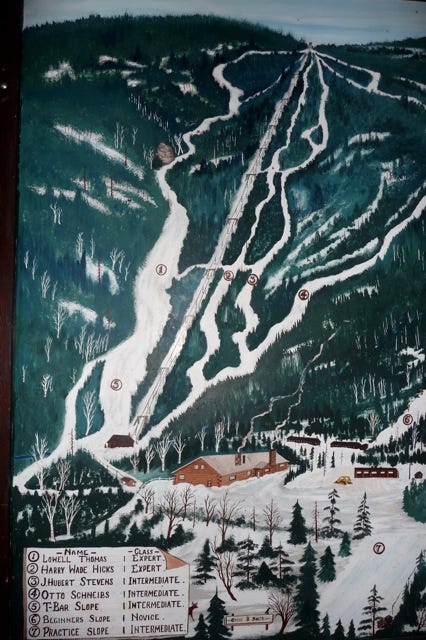
Whiteface opened in 1958, on the north side of the same mountain. This contemporary trailmap shows the Cloudsplitter trail, which Kellett tells us was part of Marble Mountain, connecting down to Whiteface:
That trail quickly disappeared from the map:
For decades, the forest moved in. Until, in 2008, Whiteface installed the Lookout Mountain Triple and revived the trail, now known as “Hoyt’s High”:
So, why did Marble Mountain go away? This excellent 2015 article from Skiing History lays it out:
To get the full benefit of the sweeping northern vista from the newly widened Wilmington Trail at Whiteface Mountain near Lake Placid, pick a calm day. Otherwise, get ready for a blast of what ski historian and meteorologist Jeremy Davis characterizes as “howling, persistent winds” that 60 years ago brought down Marble Mountain. Intended to be New York State’s signature ski resort in the 1950s, Marble lasted just 10 years before it closed. It remains the largest ski area east of the Mississippi to be abandoned.
It turns out you can’t move the mountain, so the state moved the ski area: The “new” Whiteface resort, dedicated in 1958, is just around the corner. With 87 trails and 3,430 vertical feet, Whiteface played host to the 1980 Winter Olympic alpine events and continues to host international and national competitions regularly. How close was Marble Mountain to Whiteface? Its Porcupine Lodge, just off the new Lookout Mountain chairlift, is still used by the Whiteface ski patrol.
Full read recommended.
On Gore’s glade network versus Whiteface’s
In case you haven’t noticed, Whiteface’s sister resort, Gore, has a lights-out glade network:
I’ve long wondered why Whiteface hasn’t undertaken a similarly ambitious trailblazing project. Kellett clarifies in the podcast.
On The Slides
The Slides are a rarely open extreme-skiing zone hanging off Whiteface’s summit. In case you overlooked them on the trailmap above, here’s a zoom-in view:
New York Ski Blog has put together a lights-out guide to this singular domain, with a turn-by-turn breakdown of Slides 1 through 4.
On there being noplace to stay on the mountain
While Whiteface and sister mountains Gore and Belleayre currently offer no slopeside lodging, I believe that they ought to, for a number of reasons. One, the revenue from such an enterprise would at least partially offset the gigantic tax subsidies that currently feed these mountains’ capital budgets. Two, people want to stay at the mountain. Three, if they can’t, they go where they can, which in the case of New York means Vermont or Jiminy Peak. Four, every person who is not staying at the mountain is driving there each morning in a polluting or congestion-causing vehicle. Five, yes I agree that endless slopeside condos are an eyesore, but the raw wilderness surrounding these three mountains grants ORDA a generational opportunity to construct dense, walkable, car-free villages that could accommodate thousands of skiers at varying price points within minimal acreage. In fact, the Bear Den parking lot at Whiteface, the main parking lot at Gore, and the lower parking lot at Belleayre would offer sufficient space to house humans instead of machines (or both – the cars could go underground). Long-term, U.S. skiing is going to need more of this and less everyone-drives-everyday clusterfucks.
On the M.A.X. Pass
I will remain forever miffed that Alterra did not invite Whiteface, Gore, and Belleayre to join the Ikon Pass when it cleaned out and shut down the M.A.X. Pass in 2018. Here was that pass’ roster – skiers could clock five days at each ski area:
On multi-mountain pass owners on Indy Pass
Every once in a while, some knucklehead will crack on social media that Whiteface could never join the Indy Pass because it’s part of a larger ownership group, and therefore doesn’t qualify. But they are reading the brand too literally. Indy doesn’t give a shit – they want the mountains that are going to sell passes, which is why their roster includes 22 ski areas that are owned by multi-mountain operators, including Jay Peak, its top redeemer for three seasons running:
The Storm publishes year-round, and guarantees 100 articles per year. This is article 114/100 in 2023, and number 499 since launching on Oct. 13, 2019.




